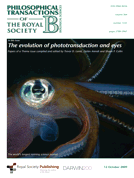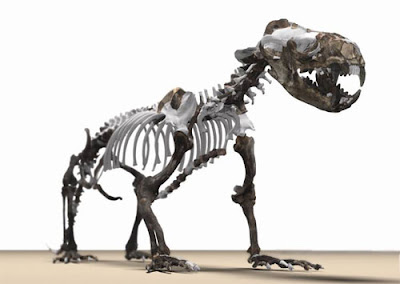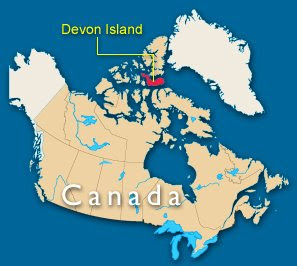Those of you who have been following this blog will know about the special issue of Evolution: Education and Outreach on the evolution of eyes that I edited last year (see below). There is now another excellent collection of papers on this subject in Philosophical Transactions of the Royal Society B, edited by eye experts Trevor D. Lamb, Detlev Arendt, and Shaun P. Collin.
The evolution of phototransduction and eyes
edited by Trevor D. Lamb, Detlev Arendt, and Shaun P. Collin
Philosophical Transactions of the Royal Society B, vol. 364, issue 1531, Oct. 19, 2009
The evolution of phototransduction and eyes
Trevor D. Lamb, Detlev Arendt, and Shaun P. Collin
Evolution of phototaxis
Gáspár Jékely
The ‘division of labour’ model of eye evolution
Detlev Arendt, Harald Hausen, and Günter Purschke
Eye evolution: common use and independent recruitment of genetic components
Pavel Vopalensky and Zbynek Kozmik
The evolution of eyes and visually guided behaviour
Dan-Eric Nilsson
The evolution of irradiance detection: melanopsin and the non-visual opsins
Stuart N. Peirson, Stephanie Halford, and Russell G. Foster
Evolution of vertebrate rod and cone phototransduction genes
Dan Larhammar, Karin Nordström, and Tomas A. Larsson
Evolution of opsins and phototransduction
Yoshinori Shichida and Take Matsuyama
Evolution and the origin of the visual retinoid cycle in vertebrates
Takehiro G. Kusakabe, Noriko Takimoto, Minghao Jin, and Motoyuki Tsuda
Evolution of vertebrate retinal photoreception
Trevor D. Lamb
The evolution of early vertebrate photoreceptors
Shaun P. Collin, Wayne L. Davies, Nathan S. Hart, and David M. Hunt
Evolution and spectral tuning of visual pigments in birds and mammals
David M. Hunt, Livia S. Carvalho, Jill A. Cowing, and Wayne L. Davies
Evolution of colour vision in mammals
Gerald H. Jacobs
The evolution of eyes
edited by T. Ryan Gregory
Evolution: Education and Outreach, vol. 1, issue 4, Oct. 2008
Editorial
351. Editorial by Gregory Eldredge and Niles Eldredge (PDF)
352-354. Introduction by T. Ryan Gregory (PDF)
355-357. Casting an Eye on Complexity by Niles Eldredge (PDF)
Original science / evolution reviews
358-389. The Evolution of Complex Organs by T. Ryan Gregory (PDF)
(Blog: Genomicron)
390-402. Opening the “Black Boxâ€: The Genetic and Biochemical Basis of Eye Evolution by Todd H. Oakley and M. Sabrina Pankey (PDF)
(Blog: Evolutionary Novelties)
403-414. A Genetic Perspective on Eye Evolution: Gene Sharing, Convergence and Parallelism by Joram Piatigorsky (PDF)
415-426. The Origin of the Vertebrate Eye by Trevor D. Lamb, Edward N. Pugh, Jr., and Shaun P. Collin (PDF)
427-438. Early Evolution of the Vertebrate Eye—Fossil Evidence by Gavin C. Young (PDF)
439-447. Charting Evolution’s Trajectory: Using Molluscan Eye Diversity to Understand Parallel and Convergent Evolution by Jeanne M. Serb and Douglas J. Eernisse (PDF)
448-462. Evolution of Insect Eyes: Tales of Ancient Heritage, Deconstruction, Reconstruction, Remodeling, and Recycling by Elke Buschbeck and Markus Friedrich (PDF)
463-475. Exceptional Variation on a Common Theme: The Evolution of Crustacean Compound Eyes by Thomas W. Cronin and Megan L. Porter (PDF)
476-486. The Causes and Consequences of Color Vision by Ellen J. Gerl and Molly R. Morris (PDF)
487-492. The Evolution of Extraordinary Eyes: The Cases of Flatfishes and Stalk-eyed Flies by Carl Zimmer (PDF)
(Blog: The Loom)
493-497. Suboptimal Optics: Vision Problems as Scars of Evolutionary History by Steven Novella (PDF)
(Blog: NeuroLogica)
Curriculum articles
498-504. Bringing Homologies Into Focus by Anastasia Thanukos (PDF)
(Website: Understanding Evolution)
505-508. Misconceptions About the Evolution of Complexity by Andrew J. Petto and Louise S. Mead (PDF)
(Website: NCSE)
509-516. Losing Sight of Regressive Evolution by Monika Espinasa and Luis Espinasa (PDF)
Book reviews
548-551. Jay Hosler, An Evolutionary Novelty: Optical Allusions by Todd H. Oakley (PDF)









